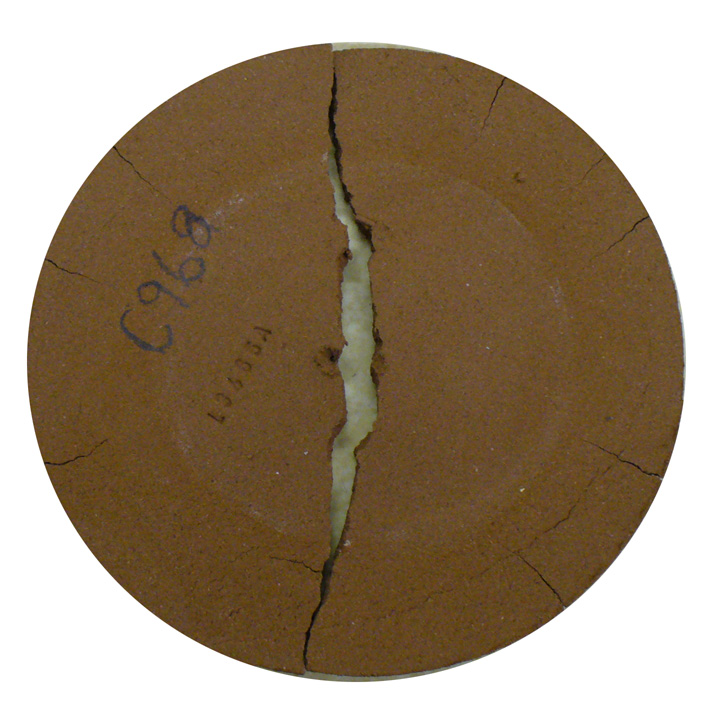| Monthly Tech-Tip | No tracking! No ads! | |
Sulfates
Soluble sulfates in clay produce efflorescence, an unsightly scum that mars the fired surface of structural and functional ceramic products.
Key phrases linking here: sulphates, sulfates - Learn more
Details
Sodium, potassium, magnesium sulfates can be found in many clays. These are soluble and migrate to the surface during drying. Soluble salts can be iron stained, but often are white. Depending on the temperature of the firing and the nature of the salt, they can leave scum on the surface (often called 'efflorescence') that ranges from dry white to melted, glossy brown. Heavy clay industries can tolerate clays with higher sulphate contents, but other industries, such as tile, need lower contents). When the clay is fired to vitrification, the salt can act as a micro-thin glaze and actually harden and give a sheen to the surface. On foot rings it can also result in plucking problems.
Related Information
Soluble salts on a range of different cone 6 fired clay brown/tan bodies

This picture has its own page with more detail, click here to see it.
The concentrations are not serious and are typical of what you might find on a commercial body.
A DFAC drying test disk of a terra cotta pottery clay from St. Ignacio, Sinaloa, Mexico

This picture has its own page with more detail, click here to see it.
This clay is used by traditional potters in the Mazatlan, Sinaloa, Mexico area. This DFAC test exhibits a very wide main crack and many edge cracks. These combine to indicate high shrinkage (a product of very high plasticity). Although the clay has some coarser grains that help channel water out, this is a very poor showing for drying performance - no large-scale manufacturer could tolerate this. But potters can and the Mexican craftsmen use it with success! How? By adapting their drying procedures. The high dry strength of this material is also a factor that helps prevent cracking. Almost any clay can be dried if the process is done evenly. And almost any can be cracked if done unevenly enough. This DFAC test is also a good indicator of the amount of soluble salts present (the slightly darker band around the perimeter), this is minimal so not scumming should appear on fired products.
How bad can efflorescence on terra cotta be?

This picture has its own page with more detail, click here to see it.
Like this! This terra cotta clay matures to good strength around 1950F. Notice how the soluble salts have concentrated on the outer and most visible surface. The piece was dried upside down so, of course, all the water had to escape through that route. A complicating factor is how handling of the piece at the leather hard stage has made it even more unsightly. This problem is common in many terra cotta materials but can also surface in others. A tiny addition of barium carbonate can precipitate the salts inside the clay matrix so they do not come to the surface on drying.
Links
| Articles |
Organic Matter in Clays: Detailed Overview
A detailed look at what materials contain organics, what its effects are in firing (e.g. black core), what to do to deal with the problem and how to measure the amount of organics in a clay material. |
| Glossary |
Deflocculation
Deflocculation is the magic behind the ceramic casting process, it enables slurries having impossibly low water contents and ware having amazingly low drying shrinkage |
| Glossary |
Efflorescence
A common problem with dry and fired ceramic. It is evident by the presence of a light or dark colored scum on the dry or fired surface. |
| Glossary |
Plucking
A firing issue in ceramics where the foot rings of vitreous ware stick to the kiln shelf. Removing them leaves sharp fragments glued to the shelf. |
| Materials |
Barium Carbonate
A pure source of BaO for ceramic glazes. This is 77% BaO and has an LOI of 23% (lost at CO2 on firing). |
| Hazards |
Barium Carbonate in Clay Bodies
Considerations regarding the use of barium carbonate in pottery and structural clay bodies for precipitation of soluble salts. |
| By Tony Hansen Follow me on        |  |
Got a Question?
Buy me a coffee and we can talk

https://digitalfire.com, All Rights Reserved
Privacy Policy
